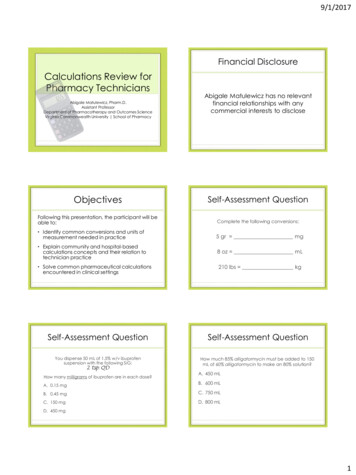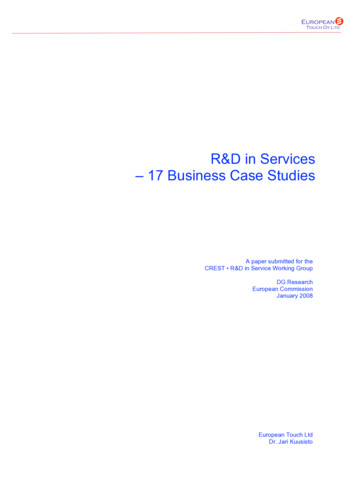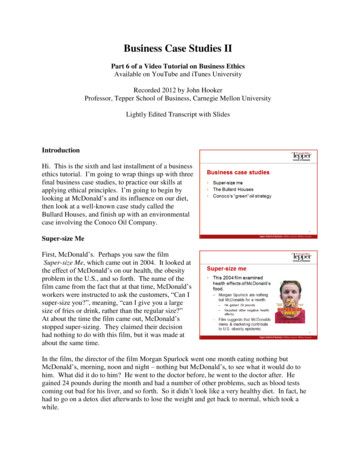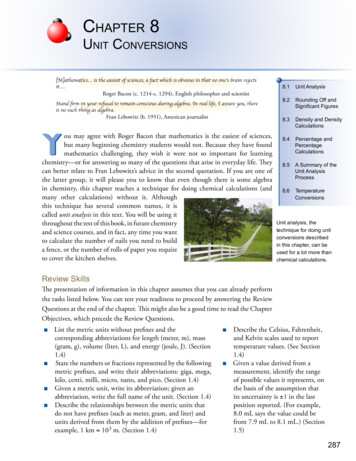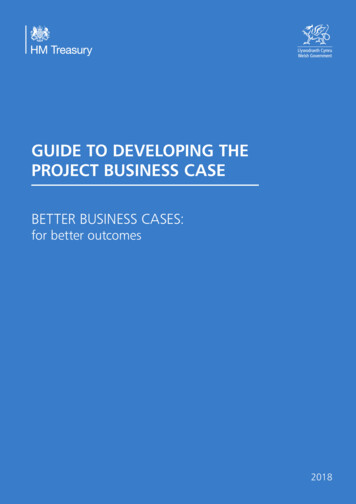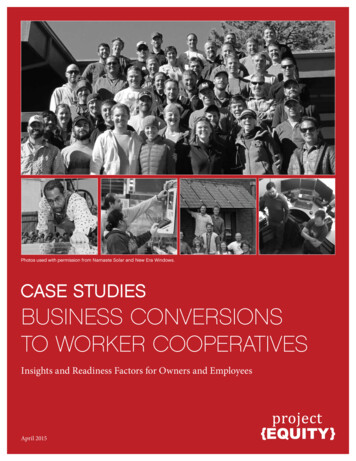
Transcription
Photos used with permission from Namaste Solar and New Era Windows.CASE STUDIESBUSINESS CONVERSIONSTO WORKER COOPERATIVESInsights and Readiness Factors for Owners and EmployeesCaseAprilStudies:2015 Business Conversions to Worker Cooperatives1 Project Equity
WelcomeABOUT PROJECT EQUITYOur mission is to foster economic resiliency in low-incomecommunities by demonstrating and replicating strategies thatincrease worker ownership. We envision a future wherecommunities (re)gain economic self determination and today’sworking poor have good jobs that keep them out of poverty andenhance their lives. We see cooperatives and employee ownershipas key elements of this future. For more information please visitwww.project-equity.org.“We envision a future where communities (re)gain economicself-determination and today’s working poor have good jobs that keepthem out of poverty and enhance their lives.” – Project EquityAuthorsAlison Lingane, Co-founderShannon Rieger, 2014 Summer InternAcknowledgementsMany thanks to Shannon Rieger, a UC Berkeley Masters student for her tremendouswork interviewing, fact checking, and pulling out the key learnings and takeawaysfrom these case studies in her role as Summer Intern for Project Equity in 2014.Without her, these case studies would not have come to fruition, and she deservesmost of the credit. Thank you, Shannon!Thank you to the Democracy at Work Institute for their help identifying and contactingthe businesses and individuals we interviewed.Thank you to the U.S. Federation of Worker Cooperatives for the full-day session onWorker Cooperative Conversions that they held in advance of their national conferencein Chicago in May 2014.Copyright & UsageCopyright 2015 Project EquityThis work is made available under the terms of the Creative Commons AttributionNonCommercial-ShareAlike 4.0 International License (CC BY-NC-SA /4.0/Case Studies: Business Conversions to Worker Cooperatives2 Project Equity
Table of ContentsExecutive Summary4Introduction6Typology of Conversions9Conversion Types10Readiness Factors12Case Study Summary18Type I Conversions1919232831Big TimberworksNamaste SolarPattycake BakeryReal PicklesType II Conversions38Island Employee CooperativeSelect MachineType II Conversions3844484852Local FlavorSimple Diaper & LinenType IV Conversions55Center Point CounselingCollective CopiesNew Era Windows CooperativeTaste of Denmark55596367Conclusion69Appendices70Appendix A: Research approach and methodsAppendix B: Case study business industries, size, location, and conversion datesCase Studies: Business Conversions to Worker Cooperatives70713 Project Equity
Executive Summary“Worker-owned cooperatives are a powerful way for employees to gaina voice in their workplace.they become the primary beneficiaries.”Employee ownership is a powerful wayfor a business owner to engage and retaintalented employees, generate communitywealth, and increase a business’ efficiencyand financial performance. Worker-ownedcooperatives in particular, are a powerfulway for employees to gain a voice in theirworkplace and in key business decisions,and to increase financial assets as theirownership stake in the business increases.1Worker-owned cooperatives differ fromother forms of business enterprise in thattheir members (the workers) are the oneswho own the business, who control it,and who are its primary beneficiaries.2lessons and effective practices from thosecompanies’ experiences.Most people don’t know how transitionsto employee ownership work: that anowner can sell the business to the employeesin order to retire or leave for other reasons,or that a business can transition to employeeownership without the owner leaving thecompany. With the growing number ofretiring baby-boomer business owners,we have an opportunity to help thosebusinesses—and their employees—harnessthe power of employee ownership.1) As an exit strategy for the owner,whether leaving for retirement or otherreasonsSo how does a business go abouttransitioning —“converting”— to aworker-owned cooperative? We set outto illustrate this by pulling together a setof case studies of businesses that haveconver ted, then highlighting key4) Because it’s good business: employee-owned businesses have demonstratedtheir ability to be more financially successfulthan their peers, and to weather economicstorms more effectively1 Hilary Abell, “Worker Cooperatives: Pathways to Scale.” TheDemocracy Collaborative. June 2014. Available at pathways-to-scale/2 op%20manual.pdf: Solidarity as a Business Model: A Multi-Stakeholder Cooperative Manual by Margaret Lundt. CooperativeDevelopment Center at Kent State UniversityWhether you are a business owner, anemployee in a business that could bea candidate for worker ownership, or apractitioner who supports businessconversions, we hope that this resourcewill deepen your understanding of theconversion process.First, we wanted to understand whatmotivated business owners and employeesto convert to a worker coop, and foundthat there are four core reasons:2) As a component of the business’mission, recognizing the employees asan important stakeholder group3) To create wealth-building opportunitiesfor employees, especially in low-wagesectorsSecond, we wanted to help businessesconsidering a transition figure out howready they are, and how they can setthemselves up for a smoother and moresuccessful transition. So, we identified aset of ‘Readiness Factors’ that emergedCase Studies: Business Conversions to Worker Cooperativesfrom the case studies that we felt wereimportant for interested businesses toconsider. These factors include theprerequisites that the business is in solidfinancial health, and that the owner andthe employees are committed to thetransition. Then, along the way, the businessneeds to either solidify or transition to aculture of transparency and participation.The team that researches and guidesthe conversion should be made up ofthe owner and a group of employees,and should maintain open internalcommunication about the process alongthe way.We also found that having externaladvisors who are employee ownershipexperts is really important, as is takingthe time to ask questions and becomeeducated about employee ownership earlyon and throughout the process. Repeatedly,we saw the benefit of hands on supportfor the employees and the owner in thenuts and bolts of setting up and runninga worker-owned company.Another key piece is ensuring thatthe financing strateg y sets the newworker coop up for success – whetherthe sales transaction is loan, equity, orowner-financed, the terms and paybacktimeline need to provide the new owners(the employees) with enough time andfinancial buffer to ensure they can meettheir financial commitments.We noted that having the owner stayactively involved over the course of thetransition is a helpful factor. It’s not always4 Project Equity
Our Study IncludesMotivations for ConversionBusiness Readiness FactorsConversion Types & CaseStudies for EachNuts & Bolts of a DozenBusiness Conversionspossible, and is more important when theowner will be vacating a key leadershipor operational role. Similarly, a phasedfinancial buy-out can help the businessmeet key milestones before taking onadditional financial commitments. Thiscan also lower the cost of external capital.And finally, having a third party valuationof the business to set the sale price canprotect all involved.Third, we identified four different typesof conversions based on the situation ofthe owners and its employees. We haveorganized the case studies into thesefour different types in an effort to makeit easier to understand similarities anddifferences:Type I: Owner sells to existing employeeswith the intention of remaining with thecompanyType II: O w ne r s el ls to e xist ingemployees with the intention of leavingthe companyType IV: Employees leave and start acoop together, or re-start a failed businessas a worker cooperativeFinally, we present case studies of adozen worker coops that were created byconverting from a more traditional businessstructure. For each, we provide high-levelbackground on the business and its situation.We talk about its motivations for becominga worker cooperative, and the logistics ofits conversion and of the coop itself. Andwe pull out the learnings by discussingthe challenges the business faced duringits conversion, the key lessons andeffective practices.These case studies provide specific detailsabout the conversion process for a diverseset of businesses. They illustrates a rangeof approaches for handling the details ofa business conversion, from the role ofthe owners and the employees, to financingoptions, to bylaw provisions that addressspecific needs and goals.Type III: Owner decides to convert toa coop, then brings in new people to befounding worker-ownersA Note From the AuthorWe hope that these case studies will serve both to de-mystify the process ofconverting a traditionally structured business into a worker-owned cooperative,and to deepen your understanding of how the process unfolds. We lookforward to your thoughts and feedback as you review them!Best regards,Alison LinganeProject Equity Co-founderCase Studies: Business Conversions to Worker Cooperatives5 Project Equity
IntroductionWhether you are a business owner, an employee in a businessthat could be a good candidate for worker ownership, or apractitioner who supports business conversions, we hopethat this resource will deepen your understanding of what itm e a n s f o r a b u s i n e s s t o c o nve r t t o a w o r ke r- o w n e dcooperative. In the text that follows, we use the term ‘owner’as shorthand to refer to the owner or owners of an existingbusiness.A WORKER-OWNED What is a worker cooperative?COOPERATIVE IS A A worker-owned cooperative is a business that is owned and run by and for its workers.BUSINESS THAT IS Worker cooperatives differ from other forms of business enterprise in that theirmembers (the workers) are the ones who own it, who control it and who are itsOWNED AND RUN primary beneficiaries.BY ITS WORKERS.34What does it mean to convert a business to a worker-ownedcooperative?“Conversion” of a business to a worker-owned cooperative means selling the businessto a newly formed worker cooperative. At a strategic level, employee ownership is apowerful way for a business owner to engage and retain talented employees, generatecommunity wealth, and increase the business’ efficiency and financial performance.5And, there can be tax advantages to the selling owner.6At the tactical level, a “conversion” is in essence three things:1) The creation of a new business entity that is a worker-owned cooperative;2) A sales transaction executed between the current owner(s) and the newworker cooperative to sell the existing business to the worker coop, typicallyfinanced by a lender such as a bank, a Community Development FinancialInstitution (CDFI), or other, by selling non-voting equity shares, or by theselling owner; and3) A transition of roles and culture among the new worker-owners to take onthe ownership responsibility of the new entity and run it under some form ofdemocratic governance.As an owner, converting to a worker-owned cooperative does not mean you have toleave the business. Many owners choose to convert to a cooperative and stay on as aworker-owner.3 See: http://ica.coop/en/what-co-operative. Accessed 1/26/154 op%20manual.pdf: Solidarity as a Business Model: A MultiStakeholder Cooperative Manual by Margaret Lundt. Cooperative Development Center at Kent State University5 ter1997-8/WhenOwnershipWin1997-8.html6 The 1042 Rollover can shelter capital gains from taxation. For more detail see htm and e Studies: Business Conversions to Worker Cooperatives6 Project Equity
But, if you are planning to retire or sell and leave your business for other reasons, it isa great way to know that you are leaving your company in experienced hands thehands of your trusted employees.Common reasons business owners decide to convert toa worker coopTHE GROWING WAVEOF AMERICAN BABYBOOMER BUSINESSOWNERS PREPARINGTO R E T I R E I S A NIMPORTANT REALITYTHAT WILL GREATLYIMPACT TO DAY ’ SBUSINESS LANDSCAPE.There are four common motivations for businesses to transition to workerownership:1) As an exit strategy for the owner, whether leaving for retirement orother reasons2) As a component of the business’ mission, recognizing the employees as animportant stakeholder group3) To create wealth-building opportunities for employees, especially inlow-wage sectors4) Because it’s good business: employee-owned businesses have demonstratedtheir ability to be more financially successful than their peers, and to weathereconomic storms more effectivelyFirst, businesses convert to worker ownership as an exit strategy for the owner,whether because s/he is retiring or wanting to leave the business for another reason.Surprisingly few current business owners in the United States have an ownershipsuccession plan. “Fewer than half of those expecting to retire in five years and one-thirdof those expecting to retire in the next 10 years have actually named a successor.” 7When looking at family-owned businesses, it turns out that only 15% make it to the 2ndgeneration and only 5% to the 3rd generation.8 If you are a business owner readingthis, or if you are working with business owners who are nearing retirement, know thatyou are not alone! The growing wave of American baby-boomer business ownerspreparing to retire is an important reality that will greatly impact today’s landscapeof locally-owned businesses. With baby boomers currently owning an estimatedtwo-thirds of all businesses with employees, there is a potentially huge impact ofkeeping those businesses anchored in our communities.9 It is forecast that trillions ofdollars of business value are going to change hands in the next 10 to 20 years. 10 Thecase studies of Island Employee Cooperative and Select Machine demonstrate thismotivation for worker coop conversion.Business owners who want to sell their businesses want a favorable financial transaction,and they typically also care about preserving the vision or mission of the business,taking care of valued customers and employees, and keeping the business alive andgrowing in the coming years. Often, owners also want to see their business stay in thecommunity it has historically served, rather than move out of town or out of state.Selling to employees can accomplish all of these goals.11Integrating employee ownership as a component of the business’ mission is7 Mark Kugar as quoted in A. McGrory-Dixon, “Small Business Owners Should Start Succession Planning Earlier,” BenefitsPro,January 24, 2012.8 http://www.oeockent.org/exit-planning/9 Baby boomers own nearly 4 million businesses, and they own 66% of all businesses with employees . See , accessed 2/17/15.10 ers-small-business-sales n 3307156.html, accessed2/17/15.11 Note that the process of selling a business to employees can take a number of different forms. Some owners choose tosell their business to their employees and transition out of the company as quickly as possible, while others prefer to sell far inadvance of their planned retirements and remain on with the business for years as worker-owners alongside their formeremployees.Case Studies: Business Conversions to Worker Cooperatives7 Project Equity
the second most common reason for converting a business to a worker cooperative.Owners, in these cases, recognize the employees as important stakeholders. Theyunderstand that worker ownership helps the company make business decisions thatare positive both for the bottom line and for the workers, gives workers a real say intheir workplace, and benefits workers financially because they share in the profits.This motivator is present in all of the case studies.A third common motivator for businesses to convert to worker ownership is rootedin worker ownership’s capacity to create opportunities for employees to build long-termwealth. 12 In lower-paying industries, in particular, this can be a powerful incentivefor employees to consider converting to worker ownership, and for local economicdevelopment agencies to support such efforts. The New Era Windows case studiesdemonstrates that worker-owners were motivated to convert not only to keep theirjobs, but also to step into ownership roles, for the short-and long-term financial benefitsas well as the decision-making benefits of ownership.The fourth reason is typically a “bonus” on top of one of more of the other three(rather than a core motivator), which is that employee-owned businesses havedemonstrated their ability to be more financially successful than their peers, and toweather economic storms more effectively.13In many conversion cases, two or even all of the reasons described above may bemotivators for owners and/or employees to make the decision to transition intoworker ownership.We have pulled together this series of case studies about businesses that have convertedto worker cooperatives in the hopes that businesses that are considering or undertakingthis transition can learn from their experiences: what worked, what the challengeswere, and how they handled particular situations of importance to them. For eachcase study, we have pulled out their motivations for becoming a coop, the logistics ofthe conversion and of the coop itself, challenges, key lessons and effective practices.We created the case studies through a combination of interviews with current coopmembers, interviews with organizations that have supported businesses in their transitionto worker coops, and from news stories and published articles.12 Hilary Abell, “Worker Cooperatives: Pathways to Scale.” The Democracy Collaborative. June 2014. Available s-pathways-to-scale/13 Ibid.Case Studies: Business Conversions to Worker Cooperatives8 Project Equity
Typology of ConversionsEvery cooperative conversion is necessarily shaped by the particularities of the business,and of the owner 14 and the workers. Since each follows a unique path, we found ithelpful to group cooperative conversions into four types in order to highlight similaritiesand differences. The case studies that follow are organized according to this typology.Type IType IIOwner sells to existing employees with the intentionof remaining with the companyOwner sells to existing employees with the intentionof leaving the company Big Timberworks Namaste Solar Pattycake Bakery Real Pickles Island Employee Cooperative Local Flavor (also Type III) Select MachineType IIIType IVOwner decides to convert to a coop, then brings innew people to be founding worker-ownersEmployees leave and start a coop together, or re-starta failed business as a worker cooperative Local Flavor (also Type II) Simple Diaper and Linen Center Point Counseling Collective Copies New Era Windows Taste of Denmark14 Our use of the word ‘owner’ throughout is shorthand for one or more owners.Case Studies: Business Conversions to Worker Cooperatives9 Project Equity
Conversion TypesType IType IOwner sells to existingemployees with theintention of remainingwith the company.The first general type of conversion includes businesses in which the selling ownerintends to remain on with the company as a worker-owner after selling to his or herexisting employees. The case studies representing this type of conversion are BigTimberworks, Namaste Solar, Pattycake Bakery and Real Pickles. Business conversionsin this category are frequently related to a mission-orientation of the business: ownersoften feel that sharing ownership with their employees ensures that the companyserves all of its workers as well and as fairly as possible. Conversions in this categorymay also be motivated by a belief that sharing the responsibilities of ownership,governance, and often management will better serve the long-term interests of thecompany (see the Big Timberworks case study for an example).This type of conversion requires the active involvement and commitment of theowner and of the existing employees who will become worker-owners. Because ofthis, careful preparation efforts are advisable before, during, and after the conversionto manage expectations, to create and clarify common understandings, and to allowfor ongoing adaptation as the conversion progresses. Type I conversions benefit fromthe pre-existing industry knowledge and skills carried over by workers during theirtransition from employees to worker-owners. On the other hand, businesses undergoingthis type of conversion may need to actively work to overcome the persistence of anemployer-employee workplace dynamic and culture, despite the legal establishmentof worker-ownership in a business’ bylaws.Type IIType IIOwner sells to existingemployees with theintention of leavingthe company.The second general type of conversion is distinct from the first in one critical way:owners sell the business to their existing employees with the intention of leaving thecompany, either for the purpose of retiring or for moving on to other endeavors.The case studies representing this type include Island Employee Cooperative, LocalFlavor (also Type III) and Select Machine. The selling owner of businesses in thiscategory of conversions use worker ownership as an alternative ownership successionstrategy, choosing to pass the business along to employees instead of to external buyersor to a younger generation of the owner’s family. This type of conversion is likely tobecome increasingly important as the baby boomer generation retires over the nextdecade and leaves many American businesses in need of new owners. Conversions ofthis type, like those of Type I, benefit from the carry-over of worker-owners’ industryknowledge from traditional employment status into shared ownership.It is important to ensure enough access to the existing owner over the right timelineto transition the owner’s strategic leadership role, business management and operationalknowledge, industry and customer relationships, and other roles the owner played orexpertise the owner uniquely holds.Case Studies: Business Conversions to Worker Cooperatives10 Project Equity
Type IIIType IIIOwner decides to convertto a coop, then brings innew people to be foundingworker-owners.A third type of conversion includes businesses in which the owner makes the decisionto convert to a worker cooperative independently of existing employees, and thenbrings in new people to become the coop’s founding worker-owners. The case studiesdescribing this conversion type are Local Flavor (also Type II) and Simple Diaper &Linen. This type of conversion may be an exit strategy for an owner who wishes toretire, or it may be a way to expand and/or ensure the longevity of a business. Thisapproach enables the owner to be strategic in assembling or hand picking the foundingworker-owners. The owner can curate the mix of skills, personalities, knowledge, andexperience that will become the foundation of the new cooperative business, ensuringthat the gaps left by the owner’s departure are effectively filled. The challenge of thisapproach is the new team’s lack of experience with the particular business and theneed to build working relationships from the ground up. There can be a hybridapproach, in which some existing employees are invited to become worker-ownersand new employees are brought in as worker-owner candidates. This hybrid approachcan help ensure that there is a solid base of employees who want to become workerowners.Type IVType IVEmployees leave and starta coop together, or re-starta failed business as aworker cooperative.A fourth general type of worker cooperative conversion is characterized by one oftwo events. A group of employees chooses to leave an existing traditionally-structuredbusiness en masse and start their own worker cooperative together. Or, formeremployees of a failed business launch a revised version of their previous company asa worker cooperative. In the first case, employees—who may be dissatisfied for anynumber of reasons—look to worker ownership as a better way to run the business(for an example, see the case study of Center Point Counseling). In the second case,employees are primarily motivated to re-start a failed business as a worker cooperativeby a desire to save their jobs and to gain a greater say in what happens to the company—and to their jobs—in the future. Case studies of this type of conversion, whichis a sort of hybridization of business conversion and start-up, include Center PointCounseling, Collective Copies, New Era Windows and Taste of Denmark. Althoughconversions of this type are fortunate in that the industry knowledge held by experiencedemployees carries over into the cooperative business, when individuals in managementroles don’t become a part of the new company, the lack of support from managementcan present an obstacle. Employees must bring on individuals with managementskills or seek out external expert advisors capable of supporting them as they gainmanagement skills to run the business successfully.Case Studies: Business Conversions to Worker Cooperatives11 Project Equity
Readiness FactorsCOOPERATIVE CONVERSION READINESS FACTORSWe wanted to understand how to assess whether a business is ready to transition to a workercooperative. The good news is that, in general, factors that contribute to the good health of abusiness also help a company be successful in the transition to worker ownership. Althoughthe context and conversion process are unique to each business, a handful of factors appearagain and again in conversions of all four types outlined here.Note that these Readiness Factors aremost applicable to conversion Types Iand II, since these are the situations inwhich there is strong continuity of thecurrent business operations and theexisting workers. In Type III conversions,there is a nearly 100% turnover ofworkers, and in Type IV, the businessis essentially re-started (and so has theopportunity to do some re-inventionand restructuring). For Types III andIV, these are factors that should be takeninto account—anddesigned for—as thenew coop is being set up.Some of the Readiness Factors areprerequisites that should be in place beforemaking a commitment to a worker coopconversion. Some are factors that businesseswill want to ensure are developed asthey prepare for a conversion. We alsoshare some factors that we consider to behelpful but not essential in every case; werecommend businesses strongly considerputting these in place, within the constraintsof the particular situation.PREREQUISITESCommitment to transitionBoth the owner and employees are committed to converting to a worker cooperative.Note: For Type III and IV conversions, when either the current owner or the employees drive a conversion independently, they needto commit to rebuilding a team by recruiting individuals with a commitment to employee ownershipBusiness is in strong financial healthSuccessful and stable business at time of conversion15Positive future business financial forecastBusiness financial planning scenarios ensure ability to cover cost of buy-out capital even in business cycle downturn15 There have been some attempts to use employee ownership to rescue failing businesses, but this is not a good idea, unless the flaws from a business perspective are directly tied to weaknesses ofa departing owner and can be easily remedied by new worker-owners. Employee-owned businesses and coops must succeed on business terms, just like any company, so a sound business modeland a strong future market are essential.Case Studies: Business Conversions to Worker Cooperatives12 Project Equity
FACTORS TO DEVELOP ALONG THE WAYParticipatory cultureA culture of transparency and participation is key to the development of an effective, well-functioning cooperative.If this is not in place already, this cultural transition should be included in the transition roadmap.Employee and owner conversion team researches and guides the conversionOpen internal communication about the conversion processAdvising, training and support for owners and employeesTrainings—and ideally, hands-on support—for employees and owner in the nuts and bolts of running aworker-owned companyExternal advising from employee ownership experts, including:Existing successful worker coops that can offer support, models and adviceOrganizational development consultants who can help guide processes and cultural shiftsLawyers, CPAs and finance experts who understand coopsEffective financingFinancing strategy that raises the right amount of capital at terms the business can afford to pay. Sources could include:Internal financing (financial support from selling owner, company retained earnings or workers’ share of profitover time, etc.)Bank or other loansEquity investment in the form of non-voting sharesOTHER HELPFUL FACTORSOwner actively involved during transitionOwner wiling and able to gradually—not suddenly—withdraw from business operations (unless staying on as aworker-owner), and stays actively and appropriately involved through transition to fully functioning worker ownershipPhased buy-outIf the owner can afford it financially and is willing, a phased buyout that enables the financial transaction to take place instages can lower risk and decrease the cost of external capitalThird party financial valuationT
We hope that these case studies will serve both to de-mystify the process of converting a traditionally structured business into a worker-owned cooperative, and

